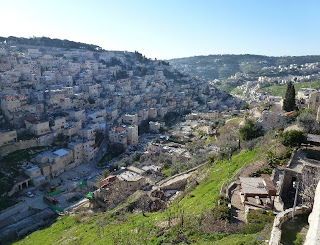Entry to the City of David Archaeological Park
The inhabitants of ancient Jerusalem didn’t live on
the site we know today as the Old City, but rather on a narrow strip descending
to the south of the present Temple Mount.
In 1,000 BC, David captured the fortress of the
Jebusites (a Canaanite tribe). The entire city wasn’t that large—about 15
acres—but it was there that David established his capital and brought to it the
Ark of the Covenant.
Graphic showing the ancient core of Jerusalem. Later, David would purchase a threshing floor on Mt. Moriah (to the north), where Solomon would erect the Temple. (Click on photo to enlarge)
Jerusalem had natural defenses; the Hinnom Valley
to the south, the Kidron Valley to the east, and the Tyropoeon (Central) Valley
to the west. (Note: not much of the Tyropoeon Valley is visible as Herod the
Great filled it with debris to expand the Temple Mount.) It also had plenty of
fresh water, supplied by the Gihon Spring.
View from the observation platform. Note: you are looking toward the south. The Kidron Valley provided a natural defense of the city to its east. (Click on photo to enlarge)
There are ongoing digs at the City of David
Archaeological Park. Standing on the observation platform, it is easy to see
how David could have looked down from his roof and spied the beautiful
Bathsheba below (2 Samuel 11: 2).



Comments
Post a Comment